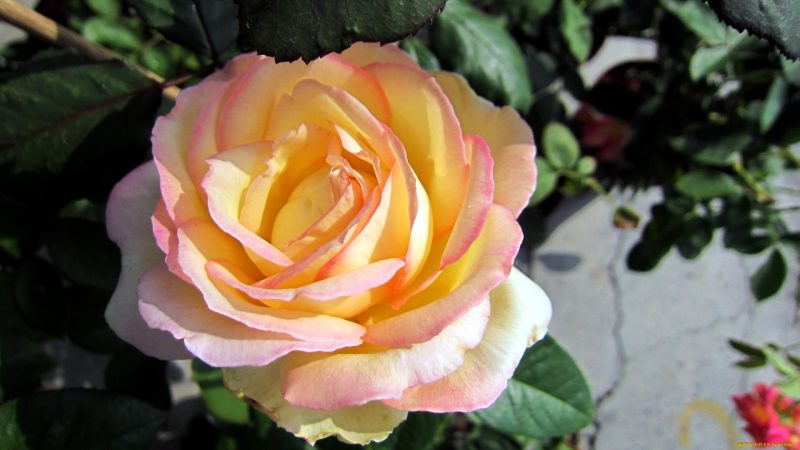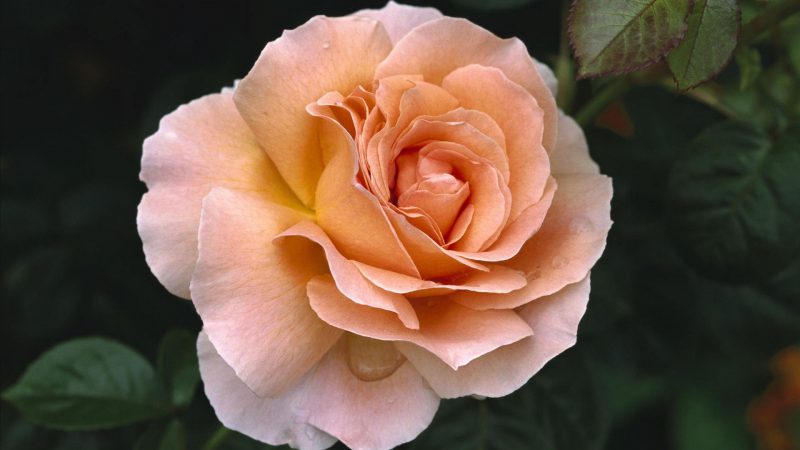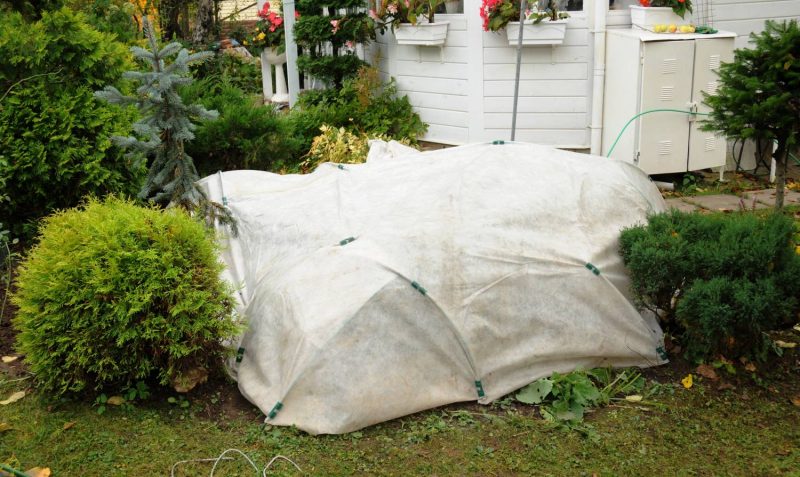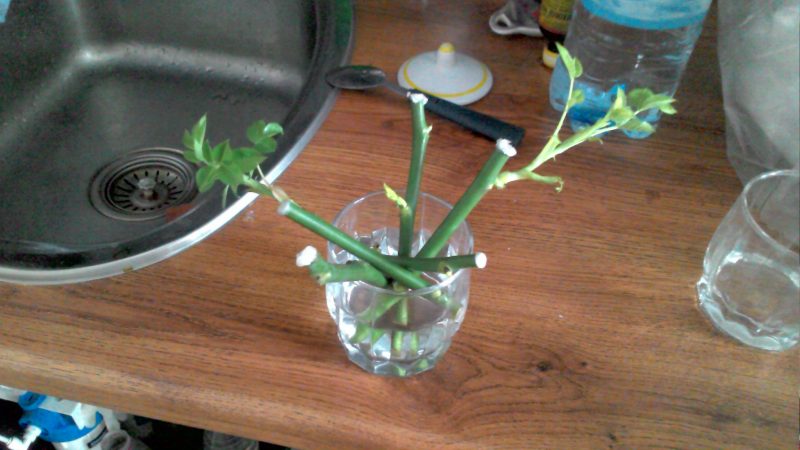Thanks to the continuous, painstaking work of breeders today, turning a garden plot into a fabulous garden surrounded by flowers and greenery has become a possible and uncomplicated task. Tea rose will help to cope with this task - the embodiment of natural beauty, which fills even the most distant corners of the garden with a refined aroma.
Material Content:
What is tea rose, description of varieties
Before you start studying agricultural cultivation techniques, it is worth understanding what it is - "tea rose". This shrubbery came to Europe in 1810 in a parcel from an agent of the British East India Company. Having received it from a nursery in Canton, he sent a fragrant beauty to England. The type species became the basis for the breeding of many varieties and forms, having lost its original characteristics in the 19th century. Today, many people confuse tea rose, which stands out with an aroma similar to the fragrance of Chinese tea, with hybrid tea, which was the result of the crossing of the first of these and repair roses.
Tea rose is a beautiful shrub variety, the height of which, the diameter of the flowers and their color depend on the particular variety. But until now, the classic color of lush buds, with up to 60 petals, is considered to be soft pink with a yellow core with a full opening of the bud.
Popular varieties that gardeners love to grow in their gardens:
- Blue moon Shrub tea rose with lilac flowers casting a silver tint. The variety is not distinguished by good heat tolerance, but it is quite resistant to damage by pathogens, for which it is widely used.
- Elina.Variety with large buds of yellow-cream color, which may vary depending on weather conditions.
- American Pride. A velvety variety that is often found in experienced gardeners who are not afraid of difficulties. Plants are demanding for watering, but in response they decorate the garden with large burgundy inflorescences (15 - 17 cm in diameter).
- Rosemary Harkness. A photophilous variety that needs a lot of sun, due to which, during flowering, the bush is abundantly covered with bright orange flowers with a salmon hue.
- Geoff Hamilton. A medium-sized variety with a height of 1 - 1.5 m, which, with delicate pink flowering, smells fragrant with notes of green apples.
- Gentle Germione. The variety is represented by sprawling bushes up to 1.2 m high with a large number of double pink flowers. They do not tolerate droplets of water falling on them.
- Gloire de Dijon. Curly shape with thin stems, covered in the flowering phase with delicate salmon flowers.
- Parade. Another tall climbing variety, distinguished by terry inflorescences of bright pink color, which can acquire an admixture of red.
Choosing Healthy Seedlings When Purchasing
The assortment of planting material in flower shops is very large.
To choose healthy and quality seedlings from this abundance, the following nuances should be taken into account:
- planting material must have at least 3 developed shoots without dark spots and other signs of disease;
- the root system should be well developed and have a cream core on the cut;
- when buying a seedling with an open root system, you should pay attention to the buds - they must be dormant.
Planting roses in the open ground
Planting a tea rose in order to get abundant and prolonged flowering should be carried out according to all the rules.
For a tea rose, a sunny area with good wind protection is selected. It is desirable that it has loose, light soil of a neutral or slightly acidic reaction.
Groundwater should lie deeper, which will prevent damage to the root system of the plant by fungal diseases in the future.
Landing work, as a rule, is carried out in late spring according to the following scheme:
- On the site, digging holes with sizes corresponding to the root system of seedlings are dug.
- Planting material is placed in water for 2 hours so that the roots are completely immersed in it.
- After the specified time, the rhizomes are lowered into the mash from manure, clay and water in a ratio of 1: 2: 1.
- Seedlings are set in the holes and sprinkled with the extracted soil.
- Trunk circles are compacted, watered.
- When the water is absorbed, the bushes swell to a height of 15 cm.
The distance between the landing pits is maintained at 50 cm. But in general, more than 8 specimens should not be planted on one site.
Agrotechnics of cultivation and care
In addition to proper planting, tea rose needs the care of a gardener, who must timely and comprehensively care for a fragrant beauty.
All varieties of tea roses are quite demanding on watering, which should be carried out according to the principle: "water should be in moderation."
Systematic waterlogging can lead to crop diseases, and overdrying can lead to a reduction in flowering time, fading buds and loss of decorativeness. Under normal weather conditions, watering roses is recommended three times a month. Water, which is carried out by the intrasoil method, must be settled and at room temperature. In the case of dry summers, the frequency of water procedures increases.
After irrigation or natural rainfall, trunks are recommended to be loosened to provide better oxygen access to the roots. Then mulching is carried out, making the evaporation of moisture not so intense. In addition, as necessary, the land under the bushes is freed from weeds.
Ensuring a balanced nutrition of plants is the key to strong immunity, in which it will be possible to achieve the highest degree of decorativeness of tea roses. Feeding is carried out with both mineral and organic fertilizers throughout the growing season.
- In the spring, after waking up, nitrogen-containing fertilizers are introduced under the bushes, stimulating the rapid growth of shoots.
- In the phases of budding and flowering, plants are necessarily fed with superphosphate and potassium sulfate, which provide an abundance of flowers that please the eye for a long time.
- The last top dressing should be carried out at the beginning of autumn with complex agrochemicals, which include potassium and phosphorus, allowing the roses to leave prepared in the winter.
Bushes are cut three times a year:
- during the development of the bush, when the desired crown is formed, by removing weak shoots and shortening strong stems to a height of 21 cm;
- in the summer to prolong flowering, when faded inflorescences are cut off;
- in the fall in preparation for the winter.
As a prophylaxis against harmful organisms that can cause great harm to the culture, it is recommended that in the autumn after pruning, remove all residues from under the bushes and burn them, thereby destroying the litter for the wintering supply of pests and pathogens.
- Before the sap flow begins, planting should be treated with copper-containing preparations.
- Before flowering, the fungicide and the insecticide in half doses should be included in the composition of the treatment solution.
This allows you to prepare an effective tank mixture with less pesticidal load on the crop.
Winter preparations
The future flowering of culture depends on wintering. In order for the tea rose to tolerate the winter well, the bushes at the end of October are freed from the leaves, cut off. A frame is installed above the plants, which is covered with roofing material and on top with a film. If possible, you can use fir spruce branches. In a milder climate, it is enough to huddle bushes to half their height.
Tea rose propagation
The simplest and most productive way in which all varietal qualities are preserved is cuttings.
With the procedure, which is carried out at the beginning of summer, when the buds are just starting to get color, the following actions are performed:
- A grassy shoot is selected.
- An 8 cm long cut is cut from its middle (it is imperative that it has 2 buds).
- One slice is made oblique, the second - straight.
- To accelerate root formation, a stalk is placed in a glass of water, where a growth stimulant is added.
- After 24 hours, the future seedling is buried in the ground, where it is covered with a plastic bottle or glass jar. The shelter is systematically removed to ventilate and water the plant.
- When leaves begin to form on the shoots, indicating successful rooting, new plants can be transferred to a permanent place of growth.
Use in landscape design
The lushly blooming “Queen of Flowers” is loved by both gardeners and professional landscape designers.
Its various varieties are often used for landscaping:
- Shrub tea rose can be planted as a tapeworm on a lawn with lush greenery and a mini fountain, near benches in a recreation area or next to the main entrance to the house, a gazebo.
- Fragrant bushes look great in compositions with shrubs and miniature conifers.
- Due to the abundance of colors, plants can be used in group plantings, caressing the eye with contrasting colors.
- Curly shapes are used to design arches, entrances to the gazebo or to decorate various buildings.
Tea rose is the top of perfection, which will be fragrant, enchanting passers-by with lush flowers, for a long time, while requiring in return from the gardener only a little care and attention.





















